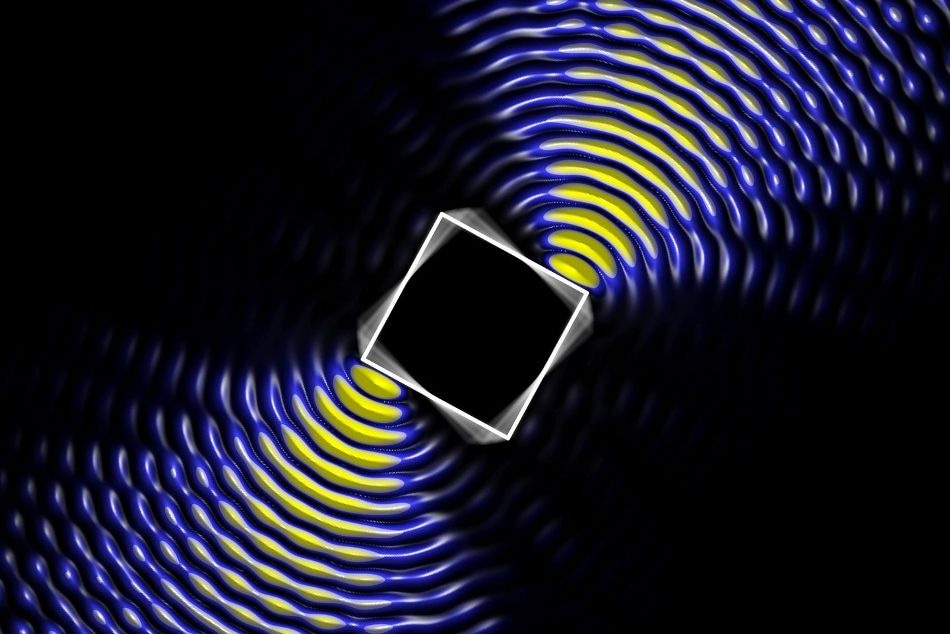Nov 20 2019
Special light beams can be used to exploit molecules or small biological particles. Even cells or viruses can be moved or captured. However, these optical tweezers work only with objects in transparent liquids or empty space.
 Tailored light wave—Intensity distribution of an electric wave field that applies a well-defined torque onto the quadratic target. Image Credit: © TU Wien.
Tailored light wave—Intensity distribution of an electric wave field that applies a well-defined torque onto the quadratic target. Image Credit: © TU Wien.
All types of disordered environments would cause light waves to deflect and destroy the effect. This is an issue, specifically with biological samples as they are generally embedded in a highly complicated environment.
However, at present, researchers at TU Wien (Vienna) have demonstrated how virtue can be created out of necessity: A unique calculation technique was devised to establish the perfect waveform to exploit small particles when a disordered environment is present. This renders it feasible to hold, move, or rotate individual particles within a sample—even if they cannot be touched straightaway.
The tailor-made light beam becomes a common remote control for all things small. Microwave experiments have already shown that the technique works. The new optical tweezer technology has currently been described in the journal Nature Photonics.
Optical Tweezers in Disordered Environments
“Using laser beams to manipulate matter is nothing unusual anymore,” explains Prof. Stefan Rotter from the Institute for Theoretical Physics at TU Wien. The 1997 Nobel Prize in Physics was given for laser beams that cool atoms by decelerating them. In 2018, another Nobel Prize in Physics acknowledged the development of optical tweezers.
However, light waves are sensitive: in an irregular, disordered environment, they can be deflected in an extremely intricate manner and dispersed in all directions. A simple, plane light wave then becomes an intricate, disordered wave pattern. This totally alters the way light interacts with a particular particle.
However, this scattering effect can be compensated, We can calculate how the wave has to be shaped initially so that the irregularities of the disordered environment transform it exactly into the shape we want it to be.
Michael Horodynski, Study First Author, TU Wien
Here, the light wave looks quite disordered and chaotic at first, but the disordered environment converts it into something ordered. Innumerable small disturbances, which would generally render the experiment impossible, are used to produce exactly the preferred waveform, which then acts on a particular particle.
Calculating the Optimal Wave
This is realized by first illuminating the particle and its disordered environment with numerous waves, and then measuring the manner in which the waves are reflected. This measurement is performed twice in rapid succession.
Let’s assume that in the short time between the two measurements, the disordered environment remains the same, while the particle we want to manipulate changes slightly. Let’s think of a cell that moves, or simply sinks downwards a little bit. Then the light wave we send in is reflected a little bit differently in the two measurements.
Stefan Rotter, Professor, Institute for Theoretical Physics, TU Wien
This minute difference is decisive: With the new calculation technique devised at TU Wien, it is now feasible to calculate the wave that has to be used to intensify or attenuate this particle movement.
If the particle slowly sinks downwards, we can calculate a wave that prevents this sinking or lets the particle sink even faster. If the particle rotates a little bit, we know which wave transmits the maximum angular momentum—we can then rotate the particle with a specially shaped light wave without ever touching it.
Stefan Rotter, Professor, Institute for Theoretical Physics, TU Wien
Successful Experiments with Microwaves
Kevin Pichler, also part of the research team at TU Wien, was able to apply the calculation technique in the lab of project partners at the University of Nice (France): he used arbitrarily arranged Teflon objects and irradiated them with microwaves—this way, he was actually successful in producing precisely those waveforms which, because of the disorder of the system, produced the anticipated effect.
“The microwave experiment shows that our method works,” noted Rotter. “But the real goal is to apply it not with microwaves but with visible light. This could open up completely new fields of applications for optical tweezers and, especially in biological research, would make it possible to control small particles in a way that was previously considered completely impossible.”